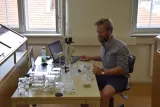Published: 20.09.2018
Czech scientists have made a surprising discovery. A metal pot buried in a tomb in Egypt's Abusir 5000 years ago was made of material that was used at the time in distant Anatolia - modern-day Turkey. They proved that the metals had travelled a few thousand miles before they got to their owner. One of the experts who examined the material used for the manufacture of the container was Ing. Jiří Kmošek, a chemist from the Department of Chemical Technology, the Faculty of Restoration.
The fact that metals had to travel a long distance is evidenced by a study in the prestigious Journal of Archaeological Science published under the title "Invisible connections. Early Dynastic and Old Kingdom Egyptian metalwork in the Egyptian Museum of the Leipzig University."
Examining ancient Egyptian artefacts
The Czech research team led in the natural science part by archaeometallurgist Jiří Kmošek of our Faculty of Restoration and Mgr. Martin Odler of the Czech Institute of Egyptology at the Faculty of Arts, Charles University, who leads the archaeological part of the research, came up with a surprising finding.
The researchers carried out a detailed analysis of twenty-two Old Kingdom Egyptian from the Egyptian Museum of Leipzig University in Germany, which were discovered during German and British research at the beginning of the 20th century on the sites of Abusir, Abydos and Giza. They come from the tomb of the king of the Second dynasty Khasekhemwy (Abydos) and from tombs of Early Dynastic officials (Abusir) and the Old Kingdom (Giza).
"I personally was responsible for sampling, metallographic analysis and statistical data evaluation. We first x-rayed the items at the Leipzig University to determine their state and degree of preservation of the metal core. At the Leipzig Museum, the items were sampled in 2015 and then the samples were taken to Prague for further assessment, " Jiří Kmošek commented on the research.
Scientists used new methods for the first time
Until now, knowledge of ancient Egyptian metallurgy in the 3rd millennium BC has been very limited. Now, Czech scientists have used new archaeological and metallurgical methods in detecting the origin of ores for the pots found - analysis of lead isotopes. Combined with the egyptological and natural scientific approaches, they have demonstrated "invisible connections" that can be traced between the regions from which the copper ore came of which the pots were made and where they were eventually made and found.
"Lead isotopes allowed us to trace where the ore came from," says the first author of the study, archaeologist Ing. Jiří Kmošek. "And they showed unexpected results," adds the correspondent author, Ph.D. student Martin Odler.
Analyses were conducted at scientific sites
Isotope analyses of lead were performed by geologist Yulia V. Kochergina of the Czech Geological Survey, physicist Fikrle analysed samples at the Institute of Nuclear Physics of the Academy of Sciences of the Czech Republic in Řež u Prahy, using neutron activation analysis and x-ray fluorescence analysis. In the Chemistry Laboratory of the Faculty of Restoration in Litomyšl, samples were analysed on an electron microscope. In addition to the expected occurrence of ores from the Sinai Peninsula, a frequent destination of ancient Egyptian expeditions, a considerable amount of ore originated from the Egyptian Eastern Desert.
An Egyptian bowl was made of ore from far Anatolia
The greatest surprise for the scientist was a huge bowl from the tomb of the First dynasty from Abusir, which was discovered in 1910 by the German Egyptologist Georg Steindorff in the rescue research of the burial ground. The ore of which it was made comes from far Anatolia.
"It contained arsenic (1.4%) and nickel (4.8%), a very unusual metal for ancient Egypt, however common in artefacts of copper and arsenic copper of Anatolia. Analyses of lead isotopes in the examined ancient Egyptian artefacts have confirmed that they are the same as those of Anatolian copper ores and similar to artefacts from the period around 3000 BC," Jiří Kmošek describes the surprising results of the analyses.
According to the authors of the study, the pot was probably made by ancient Egyptian smiths, only the ore or ingot, a metal semi-finished product, travelled from Anatolia, maybe through a number of intermediaries. Thus, the pot is not a proof of direct contact between the two cultures, but it shows how far metals travelled in the Near East in the third millennium BC.
The analysed set of ancient Egyptian artefacts, however, contains about 100 samples while the currently published study presents about a quarter. A joint project of Czech scientists will therefore continue.
In the box
The innovative research and methods used by Czech scientists, first described in a previously published scientific study in the Journal of Archaeological Sciences of the prestigious Elsevier Publishing House, are an important milestone for further interpretations of our past. It brings more light to the knowledge of the origin of raw materials used and the production of metal pots in ancient Egypt, and the functioning of the ancient Egyptian economy and other socio-cultural contexts of our history.

